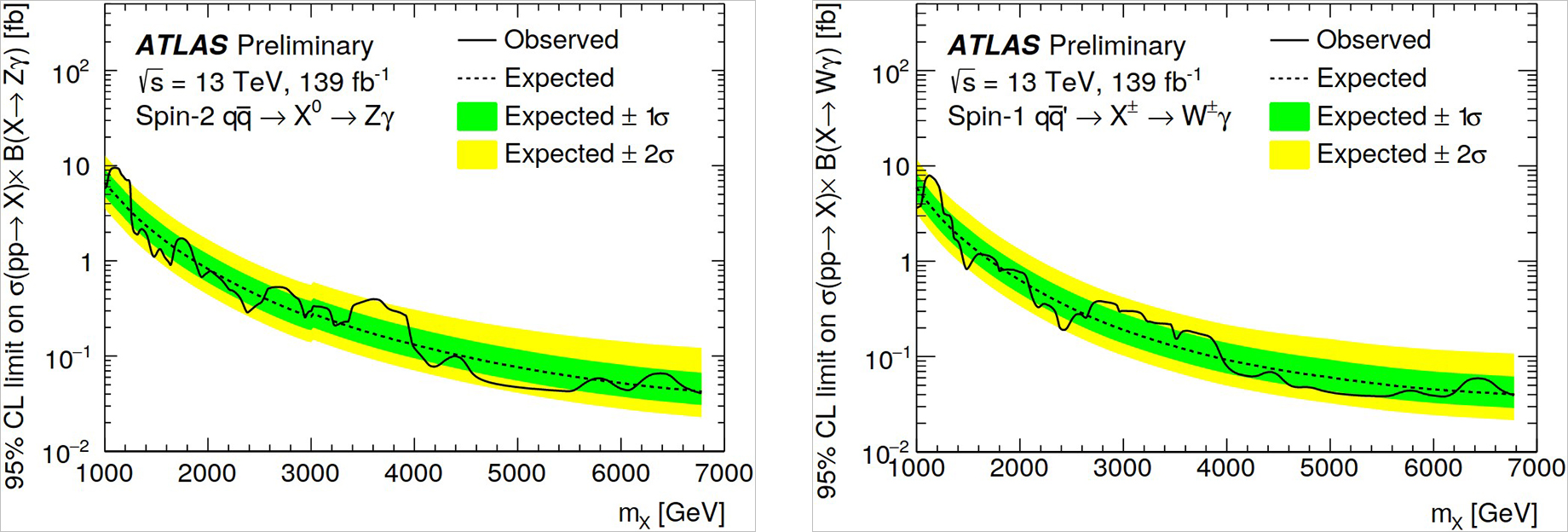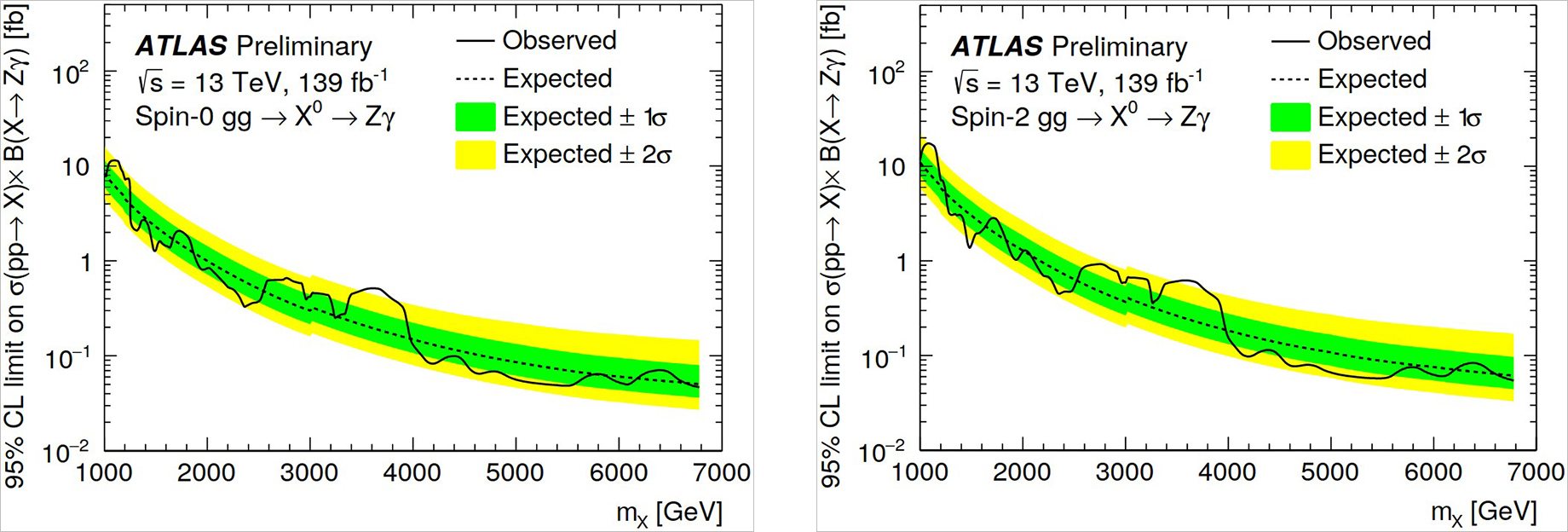JINR scientists search for evidence of existence of new physics at Large Hadron Collider
News, 09 November 2022
JINR scientists conduct research on study of properties of a Higgs boson and search for new physics in the framework of ATLAS collaboration at the Large Hadron Collider (LHC) at CERN. With the direct and critical participation of the JINR researchers international collaboration measured properties of the Higgs boson in one of its decay channels. It also studied the possibility of existence of charged or neutral heavy boson, decaying into Wγ or Zγ channels and long-lived particles, decaying into quark-antiquark pair and neutralino. The data obtained are all consistent with the Standard Model of elementary particles expectations.
As co-author of the research, Head of the Elementary Particles Sector of the Laboratory of Nuclear Problems JINR Evgeny Khramov noted, all three directions are devoted to the search for new physics beyond the Standard Model. At the same time, research on the properties of the Higgs boson is connected not with the direct search for new physics, but with the indication of it. “After the discovery of the particle, it is necessary to investigate its properties. Any deviations from the theoretical expectations will indicate that new physics exists. It can be new particles or hypotheses, depending on which property of the Higgs deviates from theoretical expectations of the Standard Model,” Evgeny Khramov commented.
Search for long-lived particles and heavy boson, in turn, is direct search for new physics. Detector has not discovered these particles yet but the theory suggests that they may exist.
“Multi-Purpose Detectors ATLAS and CMS at the Large Hadron Collider were invented, first and foremost, to discover the Higgs boson and investigate its properties, and to search for new physics beyond the Standard Model. The first task was successfully accomplished, the Higgs boson was discovered in 2012. Moreover, the validity of the Standard Model was repeatedly confirmed. Search for new physics continues via precision examination of the properties of the Higgs boson and attempts to discover new states, such as heavy boson and long-lived particles,” Evgeny Khramov said.
JINR employees measured properties of the Higgs boson decaying into bb¯ pair and produced in association with a W or Z boson decaying into leptons. To do this, the used data of proton-proton collisions collected between 2015 and 2018 by the ATLAS detector at a centre-of-mass energy of √ s =13 TeV, corresponding to an integrated luminosity of 139 fb−1. Researchers determined the production of a Higgs boson in association with a W or Z boson with observed and expected significances of 4.0 (4.1) and 5.3 (5.1) standard deviations, respectively. Cross-sections of associated production of a Higgs boson decaying into bb¯ pair with an electroweak gauge boson, W or Z, decaying into leptons are measured as a function of the gauge boson transverse momentum in kinematic fiducial volumes. The cross-section measurements are all consistent with the Standard Model expectations, and the total uncertainties vary from 30% in the high gauge boson transverse momentum regions to 85% in the low regions. Limits are subsequently set on the parameters of an effective Lagrangian sensitive to modifications of the WH and ZH processes as well as the Higgs boson decay into bb¯. (see Fig. 1).
 Fig. 1. On the left: the signal strength of the Higgs boson µbbVH, for mH = 125 GeV for the processes WH and ZH, and their combinations; On the right: the cross-section measurements of VH production with V decay into leptons and H → bb¯ at different values of the transverse momentum of the vector boson
Fig. 1. On the left: the signal strength of the Higgs boson µbbVH, for mH = 125 GeV for the processes WH and ZH, and their combinations; On the right: the cross-section measurements of VH production with V decay into leptons and H → bb¯ at different values of the transverse momentum of the vector boson
The scientist added that deviations are quite significant because researchers do not have enough data accumulated in this field so far. In future the results will be supplemented and specified.
The second research direction is the search for hypothetically long-lived particles, which have come to rest within the ATLAS detector. They are gluino R-hadrons decaying into quark-antiquark pair and neutralino. Long-lived particles are considered to live from 10 microseconds to 1000 seconds. This lifetime allows particle to fly far from the interaction point and decay deep in detector.
This investigation was unique because long-lived particles had never been searched for within the ATLAS volume previously. “All previous physical analyses at ATLAS supposed that a particle is produced at the interaction point of two protons and decays at the same place. Its lifetime is so short that it does not have time to fly far away,” Evgeny Khramov said. He added that decay detecting of long-lived particles is complicated by the necessity to carry this out between proton-proton collisions in the detector.
Decay of long-lived particles can create hadron high energy jets, which lead to large energy emission out of the event in the ATLAS calorimeter. Such decays were registered with the use of data obtained in the LHC operation mode, when there were no collisions of proton beams. Scientists analysed proton-proton collisions produced by LHC at a centre-of-mass energy of √s = 13 TeV recorded by the ATLAS experiment during 2017 and 2018. The dataset used for this search corresponds to a total live time of 579 hours. The results of this search are used to derive lower limits on the mass of gluino R-hadrons, assuming a branching fraction B(˜g → qq¯χ˜ 0 1 ) = 100%, with masses of up to 1.4 TeV excluded for gluino lifetimes of 10−5 to 103 s. (see Fig. 2).
 Fig. 2. On the left: expected (dashed lines) and observed (solid lines) exclusion limits at 95% as a function of gluino mass and its lifetime; on the right: expected (dashed lines) and observed (solid lines) signal cross-section exclusion limits at 95% as a function of gluino mass
Fig. 2. On the left: expected (dashed lines) and observed (solid lines) exclusion limits at 95% as a function of gluino mass and its lifetime; on the right: expected (dashed lines) and observed (solid lines) signal cross-section exclusion limits at 95% as a function of gluino mass
Thirdly, JINR researchers in the ATLAS collaboration investigated possibility of existence of charged or neutral heavy boson, decaying in Wy or Zy channels. For the analysis, a dataset obtained in the ATLAS experiment was used with the same parameters at which properties of the Higgs boson were investigated. The sensitivity of the analysis was tested on the heavy bosons production and decay models with the spin S=0,1 or 2. Search for heavy resonance was carried out in the mass range from 1.0 TeV to 6.8 TeV. With such large masses, the sensitivity on the analysis has an advantage in the hadron decay channel of W and Z bosons. No signs of signals exceeding the background of the Standard Model were found. Upper limits for the cross-section of the production of high-mass resonances for different models were obtained (See Fig. 3).
 Fig. 3. Upper limits at the 95% confidence level for the cross-section of the production considering decays in W/Zγ high-mass resonance channel with the spin S=0 (top left), at gluon pair fusion with the spin S=2 (top right), with the spin S=2 in coordination with quark-antiquark pair (bottom left), and with the spin S=1
Fig. 3. Upper limits at the 95% confidence level for the cross-section of the production considering decays in W/Zγ high-mass resonance channel with the spin S=0 (top left), at gluon pair fusion with the spin S=2 (top right), with the spin S=2 in coordination with quark-antiquark pair (bottom left), and with the spin S=1
“As a rule, when we do not detect any new particle we put a limit on its cross-section, define the minimum possibility of this particle production in the process of proton-proton collisions at this energy. Other scientists can use our data to reconsider their models. For example, when we say that this particle with a certain mass can no longer be produced with a certain probability. Accordingly, theorists need to modify theory, hypothesis so that the possibility of the cross-section of this particle was less than experimenters showed,” Evgeny Khramov said.
The cycle of publications “The Higgs boson properties study in b anti-b pair decay channel and search for new physics with the ATLAS detector at the Large Hadron Collider ” by F. Ahmadov (VBLHEP), E.V. Khramov (DLNP), and E.A. Cherepanova (DLNP) was awarded the JINR Encouragement Prize 2021. Works on all directions, outlined in it, continue during the RUN3 at LHC (2022 – 2025).
Publications:
- F. Ahmadov et al, Measurements of WH and ZH production in the H→b anti-b decay channel in pp collisions at 13 TeV with the ATLAS detector, Eur. Phys. J. C 81 (2021) 178
- E. Cherepanovs et al, A search for the decays of stopped long-lived particles at √s=13 TeV with the ATLAS detector, JHEP 07 (2021) 173
- E. Khramov, Search for high-mass Wγ and Zγ resonances using 139 fb−1 of pp collisions at √s = 13 TeV with the ATLAS detector, ATLAS-CONF-2021-041

